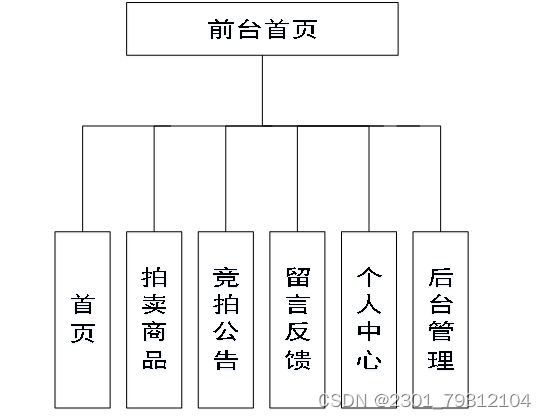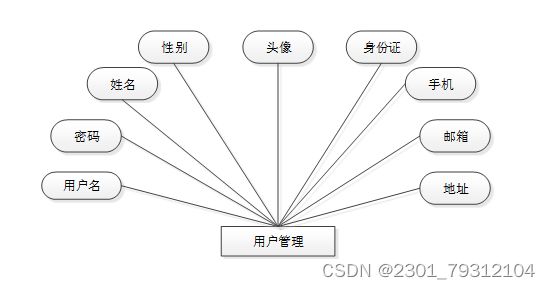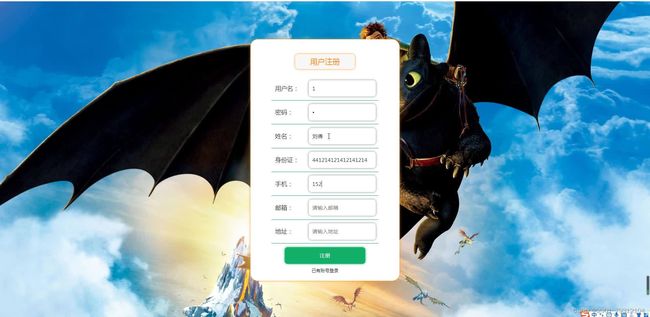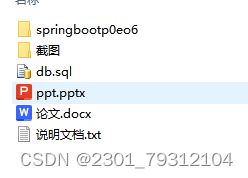基于java+SpringBoot的在线拍卖系统
提示:文章写完后,目录可以自动生成,如何生成可参考右边的帮助文档
文章目录
- 前言
- 一、系统概述
- 二、技术说明
-
- 1.核心代码
- 三、系统设计
- 四、 数据库实体
- 五、 项目效果图
- 总结
- 文章目录
前言
摘要大概内容:`
随着社会的发展,社会的各行各业都在利用信息化时代的优势。计算机的优势和普及使得各种信息系统的开发成为必需。
在线拍卖系统,主要的模块包括管理员;首页、个人中心、用户管理、商品类型管理、拍卖商品管理、历史竞拍管理、竞拍订单管理、留言板管理、系统管理,用户;首页、个人中心、历史竞拍管理、竞拍订单管理、留言板管理,前台首页;首页、拍卖商品、竞拍公告、留言反馈、个人中心、后台管理等功能。系统中管理员主要是为了安全有效地存储和管理各类信息,还可以对系统进行管理与更新维护等操作,并且对后台有相应的操作权限。
要想实现在线拍卖系统的各项功能,需要后台数据库的大力支持。管理员验证注册信息,收集的用户信息,并由此分析得出的关联信息等大量的数据都由数据库管理。本文中数据库服务器端采用了Mysql作为后台数据库,使Web与数据库紧密联系起来。在设计过程中,充分保证了系统代码的良好可读性、实用性、易扩展性、通用性、便于后期维护、操作方便以及页面简洁等特点。
本系统的开发使获取在线拍卖系统信息能够更加方便快捷,同时也使在线拍卖系统信息变的更加系统化、有序化。系统界面较友好,易于操作。
关键词:在线拍卖系统 ;Spring Boot框架;Mysql数据库
一、系统概述
随着社会的快速发展,计算机的影响是全面且深入的。人们的生活水平不断提高,日常生活中人们对在线拍卖系统方面的要求也在不断提高,在线拍卖受到广大用户的关注,使得在线拍卖系统的开发成为必需而且紧迫的事情。在线拍卖系统主要是借助计算机,通过对在线拍卖系统所需的信息管理,增加用户选择,同时也方便对广大用户信息的及时查询、修改以及对用户信息的及时了解。在线拍卖系统对用户带来了更多的便利, 该系统通过和数据库管理系统软件协作来满足用户的需求。
二、技术说明
开发语言:Java
框架:ssm
JDK版本:JDK1.8
服务器:tomcat7
数据库:mysql 5.7(一定要5.7版本)
数据库工具:Navicat11
开发软件:eclipse/myeclipse/idea
Maven包:Maven3.3.9
浏览器:谷歌浏览器
1.核心代码
代码如下(示例):
package com.controller;
import java.io.File;
import java.io.FileNotFoundException;
import java.io.IOException;
import java.text.SimpleDateFormat;
import java.util.ArrayList;
import java.util.Calendar;
import java.util.Date;
import java.util.HashMap;
import java.util.List;
import java.util.Map;
import org.apache.commons.lang3.StringUtils;
import org.json.JSONObject;
import org.springframework.beans.factory.annotation.Autowired;
import org.springframework.util.ResourceUtils;
import org.springframework.web.bind.annotation.PathVariable;
import org.springframework.web.bind.annotation.RequestBody;
import org.springframework.web.bind.annotation.RequestMapping;
import org.springframework.web.bind.annotation.RequestParam;
import org.springframework.web.bind.annotation.RestController;
import com.annotation.IgnoreAuth;
import com.baidu.aip.face.AipFace;
import com.baidu.aip.face.MatchRequest;
import com.baidu.aip.util.Base64Util;
import com.baomidou.mybatisplus.mapper.EntityWrapper;
import com.baomidou.mybatisplus.mapper.Wrapper;
import com.entity.ConfigEntity;
import com.service.CommonService;
import com.service.ConfigService;
import com.utils.BaiduUtil;
import com.utils.FileUtil;
import com.utils.R;
/**
* 通用接口
*/
@RestController
public class CommonController{
@Autowired
private CommonService commonService;
@Autowired
private ConfigService configService;
private static AipFace client = null;
private static String BAIDU_DITU_AK = null;
@RequestMapping("/location")
public R location(String lng,String lat) {
if(BAIDU_DITU_AK==null) {
BAIDU_DITU_AK = configService.selectOne(new EntityWrapper<ConfigEntity>().eq("name", "baidu_ditu_ak")).getValue();
if(BAIDU_DITU_AK==null) {
return R.error("请在配置管理中正确配置baidu_ditu_ak");
}
}
Map<String, String> map = BaiduUtil.getCityByLonLat(BAIDU_DITU_AK, lng, lat);
return R.ok().put("data", map);
}
/**
* 人脸比对
*
* @param face1 人脸1
* @param face2 人脸2
* @return
*/
@RequestMapping("/matchFace")
public R matchFace(String face1, String face2) {
if(client==null) {
/*String AppID = configService.selectOne(new EntityWrapper().eq("name", "AppID")).getValue();*/
String APIKey = configService.selectOne(new EntityWrapper<ConfigEntity>().eq("name", "APIKey")).getValue();
String SecretKey = configService.selectOne(new EntityWrapper<ConfigEntity>().eq("name", "SecretKey")).getValue();
String token = BaiduUtil.getAuth(APIKey, SecretKey);
if(token==null) {
return R.error("请在配置管理中正确配置APIKey和SecretKey");
}
client = new AipFace(null, APIKey, SecretKey);
client.setConnectionTimeoutInMillis(2000);
client.setSocketTimeoutInMillis(60000);
}
JSONObject res = null;
try {
File file1 = new File(ResourceUtils.getFile("classpath:static/upload").getAbsolutePath()+"/"+face1);
File file2 = new File(ResourceUtils.getFile("classpath:static/upload").getAbsolutePath()+"/"+face2);
String img1 = Base64Util.encode(FileUtil.FileToByte(file1));
String img2 = Base64Util.encode(FileUtil.FileToByte(file2));
MatchRequest req1 = new MatchRequest(img1, "BASE64");
MatchRequest req2 = new MatchRequest(img2, "BASE64");
ArrayList<MatchRequest> requests = new ArrayList<MatchRequest>();
requests.add(req1);
requests.add(req2);
res = client.match(requests);
System.out.println(res.get("result"));
} catch (FileNotFoundException e) {
e.printStackTrace();
return R.error("文件不存在");
} catch (IOException e) {
e.printStackTrace();
}
return R.ok().put("data", com.alibaba.fastjson.JSONObject.parse(res.get("result").toString()));
}
/**
* 获取table表中的column列表(联动接口)
* @param table
* @param column
* @return
*/
@IgnoreAuth
@RequestMapping("/option/{tableName}/{columnName}")
public R getOption(@PathVariable("tableName") String tableName, @PathVariable("columnName") String columnName,String level,String parent) {
Map<String, Object> params = new HashMap<String, Object>();
params.put("table", tableName);
params.put("column", columnName);
if(StringUtils.isNotBlank(level)) {
params.put("level", level);
}
if(StringUtils.isNotBlank(parent)) {
params.put("parent", parent);
}
List<String> data = commonService.getOption(params);
return R.ok().put("data", data);
}
/**
* 根据table中的column获取单条记录
* @param table
* @param column
* @return
*/
@IgnoreAuth
@RequestMapping("/follow/{tableName}/{columnName}")
public R getFollowByOption(@PathVariable("tableName") String tableName, @PathVariable("columnName") String columnName, @RequestParam String columnValue) {
Map<String, Object> params = new HashMap<String, Object>();
params.put("table", tableName);
params.put("column", columnName);
params.put("columnValue", columnValue);
Map<String, Object> result = commonService.getFollowByOption(params);
return R.ok().put("data", result);
}
/**
* 修改table表的sfsh状态
* @param table
* @param map
* @return
*/
@RequestMapping("/sh/{tableName}")
public R sh(@PathVariable("tableName") String tableName, @RequestBody Map<String, Object> map) {
map.put("table", tableName);
commonService.sh(map);
return R.ok();
}
/**
* 获取需要提醒的记录数
* @param tableName
* @param columnName
* @param type 1:数字 2:日期
* @param map
* @return
*/
@IgnoreAuth
@RequestMapping("/remind/{tableName}/{columnName}/{type}")
public R remindCount(@PathVariable("tableName") String tableName, @PathVariable("columnName") String columnName,
@PathVariable("type") String type,@RequestParam Map<String, Object> map) {
map.put("table", tableName);
map.put("column", columnName);
map.put("type", type);
if(type.equals("2")) {
SimpleDateFormat sdf = new SimpleDateFormat("yyyy-MM-dd");
Calendar c = Calendar.getInstance();
Date remindStartDate = null;
Date remindEndDate = null;
if(map.get("remindstart")!=null) {
Integer remindStart = Integer.parseInt(map.get("remindstart").toString());
c.setTime(new Date());
c.add(Calendar.DAY_OF_MONTH,remindStart);
remindStartDate = c.getTime();
map.put("remindstart", sdf.format(remindStartDate));
}
if(map.get("remindend")!=null) {
Integer remindEnd = Integer.parseInt(map.get("remindend").toString());
c.setTime(new Date());
c.add(Calendar.DAY_OF_MONTH,remindEnd);
remindEndDate = c.getTime();
map.put("remindend", sdf.format(remindEndDate));
}
}
int count = commonService.remindCount(map);
return R.ok().put("count", count);
}
/**
* 单列求和
*/
@IgnoreAuth
@RequestMapping("/cal/{tableName}/{columnName}")
public R cal(@PathVariable("tableName") String tableName, @PathVariable("columnName") String columnName) {
Map<String, Object> params = new HashMap<String, Object>();
params.put("table", tableName);
params.put("column", columnName);
Map<String, Object> result = commonService.selectCal(params);
return R.ok().put("data", result);
}
/**
* 分组统计
*/
@IgnoreAuth
@RequestMapping("/group/{tableName}/{columnName}")
public R group(@PathVariable("tableName") String tableName, @PathVariable("columnName") String columnName) {
Map<String, Object> params = new HashMap<String, Object>();
params.put("table", tableName);
params.put("column", columnName);
List<Map<String, Object>> result = commonService.selectGroup(params);
return R.ok().put("data", result);
}
/**
* (按值统计)
*/
@IgnoreAuth
@RequestMapping("/value/{tableName}/{xColumnName}/{yColumnName}")
public R value(@PathVariable("tableName") String tableName, @PathVariable("yColumnName") String yColumnName, @PathVariable("xColumnName") String xColumnName) {
Map<String, Object> params = new HashMap<String, Object>();
params.put("table", tableName);
params.put("xColumn", xColumnName);
params.put("yColumn", yColumnName);
List<Map<String, Object>> result = commonService.selectValue(params);
SimpleDateFormat sdf = new SimpleDateFormat("yyyy-MM-dd");
for(Map<String, Object> m : result) {
for(String k : m.keySet()) {
if(m.get(k) instanceof Date) {
m.put(k, sdf.format((Date)m.get(k)));
}
}
}
return R.ok().put("data", result);
}
}
三、系统设计
图4-3 管理员功能结构图
前台首页功能结构图,如图4-4所示:

图4-4 前台首页功能结构图
图4-5用户功能结构图
四、 数据库实体
图4-6 管理员信息实体结构图
拍卖商品管理实体属性图,如图4-7所示:

图4-7拍卖商品管理实体属性图
用户管理实体属性图如图4-8所示。

图4-8用户管理实体属性图
图4-9历史竞拍管理实体属性图
五、 项目效果图
总结
本系统通过对Java和Mysql数据库的简介,从硬件和软件两反面说明了在线拍卖系统的可行性,本文结论及研究成果如下:实现了Java与Mysql相结合构建的在线拍卖系统 ,网站可以响应式展示。通过本次在线拍卖系统的研究与实现,我感到学海无涯,学习是没有终点的,而且实践出真知,只有多动手才能尽快掌握它,经验对系统的开发非常重要,经验不足,就难免会有许多考虑不周之处。比如要有美观的界面,更完善的功能,才能吸引更多的用户 。
由于在此之前对于java知识没有深入了解,所以从一开始就碰到许多困难,例如一开始的页面显示不规范、数据库连接有问题已经无法实现参数的传递等等,不过通过在网上寻找有关资料以及同学的帮助下最后都得到了解决,在此过程中,我不仅学到了很多知识,也提高了自己解决问题的能力,尤其是学会如何从大量的信息中筛选出所需有用的信息,同时我更加深刻的体会到了,虽然书本上的大部分知识都是有价值,正确的,但实际上每个人编程的思路和对数据处理的方法、思想都是不同的,这就要求我们一定要通过实践才能找到解决问题的方案。在此次毕业设计活动中,我不断的提高了自己,也得到了宝贵的经验,我相信这些对我以后的发展都会有很大帮助。
通过这次在线拍卖系统的开发,我参考了很多相关系统的例子,取长补短,吸取了其他系统的长处,逐步对该系统进行了完善,但是该系统还是有很多的不足之处,有待以后进一步学习。
文章目录
目 录
摘 要 1
Abstract 1
1 系统概述 4
1.1 概述 4
1.2课题意义 4
1.3 主要内容 4
2 系统开发环境 5
2.1相关技术 5
2.2 Java技术 5
2.3 MySQL数据库 5
2.4 Tomcat介绍 6
2.5 Spring Boot框架 6
3 需求分析 7
3.1技术可行性:技术背景 7
3.2经济可行性 7
3.3操作可行性: 8
3.4系统设计规则 8
3.5系统流程和逻辑 8
4系统概要设计 12
4.1 概述 12
4.2 系统结构 12
4.3 数据库设计 14
4.3.1 数据库实体 14
4.3.2 数据库设计表 16
4.4 数据表 16
第5章 系统详细设计 19
5.1管理员功能模块 21
5.2用户功能模块 25
5.3前台首页功能模块 25
6 系统测试 27
6.1系统测试的目的 27
6.2系统测试方法 28
6.3 测试结果 28
结论 29
致 谢 30
参考文献 31










